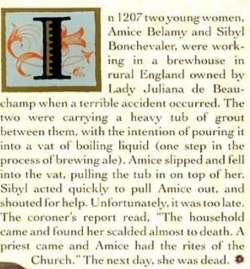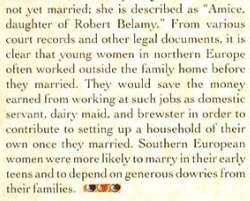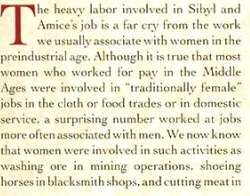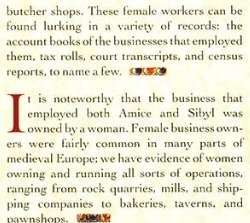|
Early Women in Business
In our ignorance (and somewhat self-centredness), we tend to think of women in
management as a new phenomenon, but according to this coroner's report from
the year 1207, this just isn't so: In 1207, two young women,
Amice Belamy and Sibyl Bonchevaler, were working in a brewhouse in
rural England owned by Lady Juliana de Beauchamp when a terrible
accident occurred. The two were carrying a heavy tub of grout
between them, with the intention of pouring it into a vat of
boiling liquid (one step in the process of brewing ale). Amice
slipped and fell into the vat, pulling the tub in on top of her.
Sibyl acted quickly to pull Amice out and shouted for help.
Unfortunately, it was too late. The coroner's report read, "The
household came and found her scalded almost to death. A priest
came and Amice had the rites of the church". The next day she was
dead. The coroner's report said that Amice was not yet married; she
is described as "Amice, daughter of Robert Bellamy". From various
court records and other legal documents, it is clear that young
women in northern Europe often worked outside the family home
before they married. They would save the money earned from working
such jobs as domestic servant, dairy maid, and brewster in order
to contribute to setting up a household of their own once they
married. Southern European women were more likely to marry in
their early teens and to depend on generous doweries from their
families.
The heavy labour involved in Sibyl and Amice's job is a far cry
from the work we usually associate with women in the
pre-industrial age. Although it is true that most women who worked
for pay in the middle ages were involved in "traditionally female"
jobs in the cloth or food trades, or in domestic service, a
surprising number worked at jobs more often associated with men.
We now know that women were involved in such activities as washing
ore in mining operations, shoeing horses in blacksmith shops, and
cutting meat in butcher shops. These female workers can be found
lurking in a variety of records: the account books of the
businesses that employed them, tax rolls, court transcripts, and
census reports to name a few.
It is noteworthy that the business that employed both
Amice and Sibyl was owned by a woman. Female business owners were
fairly common in many parts of medieval Europe; we have evidence
of women owning and running all sorts of operations, ranging from
rock quarries, mills, and shipping companies to bakeries, taverns,
and pawnshops.
Amt, E. (Ed.) (1993).
Women's Lives in Medieval Europe.
New York and London: Routledge.
Found on the Internet:
http://mahan.wonkwang.ac.kr/link/med/feminism/work/main.html

The coroner's report said that Amice was


 |
| Social conservatives have
blamed Betty Friedan for luring women out of their homes and
into the work world but we were already there in numbers
large enough to have an effect on society when Friedan wrote
her famous book in 1963. It partly started with the Second
World War when women were needed in the factories and other
work places to replace the men who were needed on the front
lines. Families found that two paycheques were helpful, and
women found that working outside the home was often more
meaningful than just being at home. It was Betty Friedan who
let out the secret that cake mix manufacturers added to the
instructions to add two eggs so that women using their cake
mixes would feel they had contributed more to the process of
making the cake! Talk about feeling fulfilled! No wonder
work outside the home had begun to look appealing. |
 |
This is a Writing
Intensive Course
 |
Exercise
dian marino |
Using the piece on
the early history of women in management, write a
statement that demonstrates the "epistemological showdown"
and one that is an "i" statement. I will
use these to try to be sure you know the difference
between these two important terms which you will need to
use in your assignments. Click below to review these
terms.
Post your answer in the
Moodle
Discussion Group. |
|
Check out this important link:
Grading Essays
 |
Exercise
Grading Essays |
In your own words,
not those from the website, what is the difference
between these four terms?
Content, Relevance, Style, Structure
Post your answer
in the
Moodle
Discussion Group. |
|
|